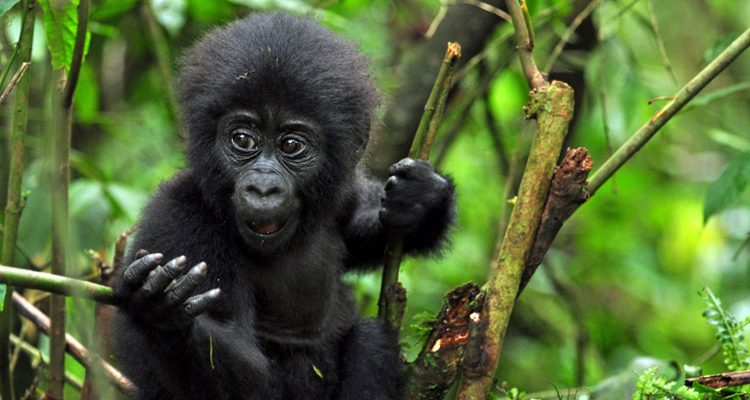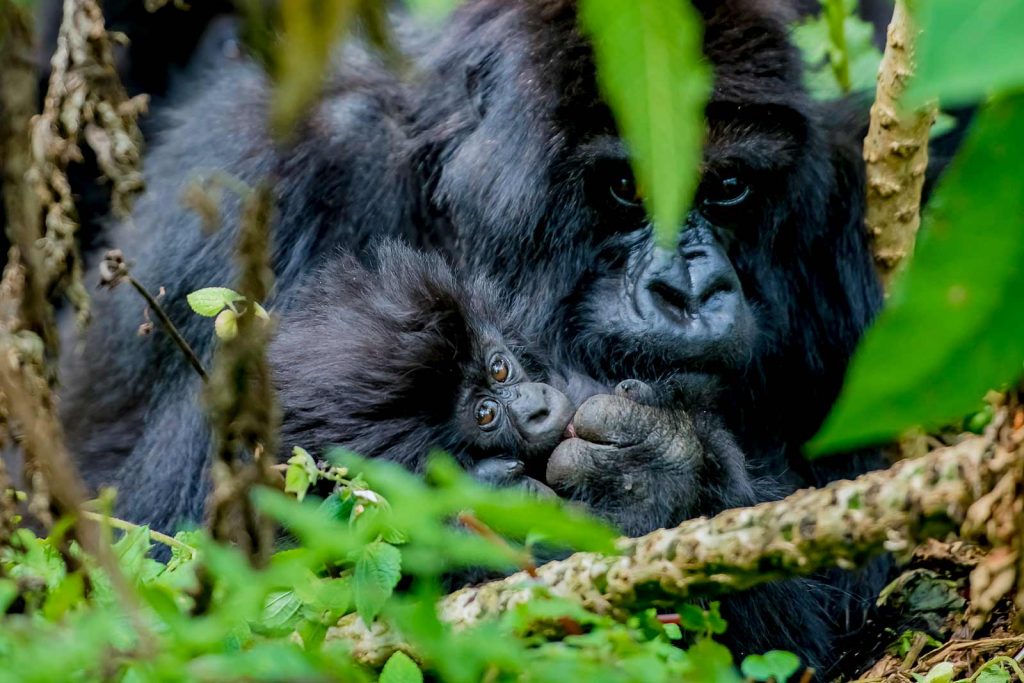Rwanda Uganda Gorillas
Rwanda and Uganda are two East African countries known for their conservation efforts and opportunities to see mountain gorillas in the wild.
Mountain gorillas are an endangered species, and both countries have established national parks where you can go gorilla trekking to observe them in their natural habitat.
Rwanda:
- Volcanoes National Park: Located in the northwestern part of Rwanda, Volcanoes National Park is famous for its mountain gorilla populations. Visitors can participate in gorilla trekking excursions that allow them to get up close to these majestic creatures. The park is home to several habituated gorilla families, making it a popular destination for gorilla enthusiasts.
Uganda:
- Bwindi Impenetrable National Park: Located in southwestern Uganda, Bwindi Impenetrable National Park is another prime location for gorilla trekking. It is home to approximately half of the world’s remaining mountain gorilla population. In addition to gorillas, the park is rich in biodiversity, with various other primate species and wildlife.
- Mgahinga Gorilla National Park: This park, also in southwestern Uganda, is part of the larger Virunga Conservation Area, shared with Rwanda and the Democratic Republic of the Congo. It offers gorilla trekking opportunities and is home to one habituated gorilla family.

Both Rwanda and Uganda have taken significant steps to protect their mountain gorilla populations and promote sustainable tourism.
Gorilla trekking permits are required in both countries and are limited to a certain number of visitors each day to minimize disturbance to the gorillas and their habitat. It’s important to plan your trip well in advance and follow all regulations to ensure a responsible and ethical gorilla trekking experience.
These experiences provide a unique opportunity to witness these incredible creatures in their natural environment while contributing to their conservation and the local communities’ development.
Volcanoes National Park:
Volcanoes National Park, also known as Parc National des Volcans (PNV), is one of Rwanda’s most famous and iconic national parks.
It is located in the northwestern part of Rwanda, near the border with Uganda and the Democratic Republic of the Congo.
The park covers an area of approximately 160 square kilometres and is part of the larger Virunga Massif, a chain of eight volcanic mountains that span Rwanda, Uganda, and the Democratic Republic of the Congo. Here is more information about Volcanoes National Park:
Mountain Gorilla Conservation:
Volcanoes National Park is internationally renowned for its efforts in mountain gorilla conservation. The park is home to several habituated gorilla families, and it offers one of the best opportunities in the world to observe these magnificent creatures in their natural habitat.
The work of dedicated researchers and conservationists in the park has played a significant role in the recovery of the mountain gorilla population.
Gorilla Trekking:
The park’s primary attraction is gorilla trekking. Visitors can obtain permits to go on guided treks to see the mountain gorillas.
These treks are usually organized in small groups, and tourists have a chance to spend an hour observing the gorillas once they are found. The experience is highly regulated to minimize the impact on the gorillas and their environment.
Scenic Beauty:
In addition to gorillas, Volcanoes National Park boasts stunning natural beauty. The park’s landscape is characterized by lush bamboo forests, dense rainforests, and a series of volcanic peaks.
The Virunga Massif’s volcanic mountains create a breathtaking backdrop for the entire park.
Other Wildlife:
While mountain gorillas are the star attraction, the park is also home to other wildlife, including golden monkeys, various bird species, and small mammals.
Golden monkey trekking is another popular activity within the park.
Cultural Encounters:
The surrounding area is inhabited by the local population known as the Banyarwanda. Tourists can engage in cultural encounters to learn about the traditions, customs, and daily life of these communities.
Conservation and Research:
The park is dedicated to the conservation of the mountain gorillas and their habitat. It plays a crucial role in gorilla research, as well as efforts to protect these endangered animals.
Visitors can sometimes participate in conservation and research activities as part of their experience.
Permits and Regulations:
To visit Volcanoes National Park and participate in gorilla trekking or other activities, you need to obtain a permit. These permits are in high demand and should be booked well in advance. The park enforces strict rules to ensure the well-being of the gorillas and the safety of visitors.
Volcanoes National Park is not only a place of great natural beauty but also a hub for important conservation efforts and a prime destination for those who want to embark on a once-in-a-lifetime gorilla trekking adventure.
It offers a unique opportunity to witness these magnificent creatures and their habitat, while contributing to their long-term protection and the sustainable development of local communities.
Bwindi Impenetrable National Park
Bwindi Impenetrable National Park, often simply referred to as Bwindi National Park, is one of Uganda’s most famous and biodiverse protected areas. Here’s a more detailed overview of this remarkable park:
Location:
- Bwindi Impenetrable National Park is situated in southwestern Uganda, near the borders with the Democratic Republic of the Congo and Rwanda.
- It covers an area of approximately 331 square kilometers (128 square miles) and is part of the larger Virunga Conservation Area, which includes Volcanoes National Park in Rwanda and Virunga National Park in the Democratic Republic of the Congo.
Geography and Name:
- The park gets its name from the dense, impenetrable vegetation that characterizes the area. The thick, lush forest is home to a vast array of plant and animal species, including the endangered mountain gorillas.
- The park’s landscape is hilly and rugged, with elevations ranging from 1,160 meters to 2,607 meters (3,806 feet to 8,553 feet) above sea level. This diverse topography contributes to the park’s rich biodiversity.
Biodiversity:
- Bwindi is renowned for its exceptional biological diversity. It is a UNESCO World Heritage Site and one of the most biologically diverse areas in Africa.
- The park is home to about half of the world’s remaining mountain gorilla population, making it a primary destination for gorilla trekking. There are several habituated gorilla families in the park, and visitors can obtain permits to track and observe these incredible creatures.
- In addition to gorillas, Bwindi National Park is a habitat for numerous other primates, including chimpanzees, various monkey species, and several bird species.
- The park boasts over 160 species of trees and more than 100 species of ferns, which contribute to its lush and impenetrable forest cover.
Conservation:
- Conservation efforts in Bwindi National Park have focused on the protection of its unique biodiversity, especially the mountain gorillas. The park’s management, in collaboration with various organizations and government bodies, has played a significant role in gorilla conservation and research.
- Tourist activities such as gorilla trekking generate revenue that is reinvested in park management, conservation initiatives, and the development of local communities.
- The park is also involved in various research and monitoring projects to better understand and protect the gorilla population.
Tourism:
- Gorilla trekking is the primary tourist attraction in Bwindi National Park. To participate in gorilla trekking, visitors need to obtain a permit, which allows them to spend a limited amount of time with a habituated gorilla family. It is a once-in-a-lifetime experience to observe these majestic animals up close in their natural habitat.
- Besides gorilla trekking, the park offers other activities like bird watching, forest walks, and guided nature hikes. The forest is rich in biodiversity and offers opportunities for wildlife enthusiasts and nature lovers.
- Tourist infrastructure in the area includes lodges, camps, and visitor centers that cater to travelers’ needs.
Bwindi Impenetrable National Park is not only a vital hub for gorilla conservation but also a remarkable destination for anyone interested in experiencing the unique beauty and biodiversity of the African rainforest.
It provides an opportunity to connect with nature, support conservation efforts, and contribute to the well-being of local communities.
Mgahinga Gorilla National Park:
Mgahinga Gorilla National Park is a protected area located in the southwestern corner of Uganda, near the border with Rwanda and the Democratic Republic of the Congo.
The park covers an area of approximately 33.7 square kilometers and is part of the Virunga Conservation Area, which is a transboundary initiative involving Uganda, Rwanda, and the Democratic Republic of the Congo to protect the region’s biodiversity, including the endangered mountain gorillas.
Key details about Mgahinga Gorilla National Park:
Mountain Gorilla Habitat:
One of the main attractions of the park is its population of mountain gorillas. It is home to one habituated gorilla family, which means that visitors have the opportunity to trek and observe these gentle giants in their natural habitat.
While Bwindi Impenetrable National Park in Uganda and Volcanoes National Park in Rwanda are more well-known for gorilla trekking, Mgahinga offers a unique and less crowded experience.
Diverse Wildlife:
In addition to mountain gorillas, Mgahinga is home to a variety of other wildlife, including golden monkeys, which are another critically endangered primate species.
Visitors can go on golden monkey tracking excursions to see these playful and colorful monkeys. The park is also home to a range of bird species and other wildlife like forest elephants and buffaloes.
Volcanic Landscape:
The park’s terrain is characterized by the volcanic Virunga Mountains, which includes three major peaks: Mount Muhabura, Mount Gahinga, and Mount Sabyinyo. The landscape is both stunning and challenging, making for an interesting trekking experience.
Hiking and Trekking:
Besides gorilla and golden monkey tracking, Mgahinga offers various hiking and trekking opportunities, including a chance to hike to the summits of the Virunga Mountains. The trails are known for their scenic beauty and offer breathtaking views of the surrounding region.
Cultural Experiences:
The communities around Mgahinga Gorilla National Park are predominantly Batwa pygmies, who are indigenous forest-dwelling people. You can engage in cultural experiences and learn about the traditions and lifestyle of the Batwa through guided tours and cultural performances.
Conservation Efforts:
The park is committed to the conservation of mountain gorillas and their habitat. Revenue generated from tourism activities goes toward funding conservation efforts, protecting the park, and supporting local communities.
Permits and Regulations:
As with other gorilla trekking destinations, a limited number of permits are issued each day to minimize the impact on the gorillas. It’s essential to book your permits in advance and adhere to the park’s regulations for responsible wildlife tourism.
In conclusion, Rwanda and Uganda are two East African countries renowned for their efforts in conserving and protecting the endangered mountain gorillas. Both countries offer unique and memorable opportunities to experience these magnificent creatures in their natural habitat through gorilla trekking.


